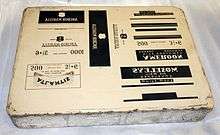lithography
English

A stone used in early forms of lithography.
Etymology
From German Lithographie, from λίθος (líthos, “stone”) + γράφειν (gráphein, “to write”). Originally the printing surface was a flat piece of limestone that was treated with grease to form a surface that would selectively transfer ink to the paper; the stone has now been replaced, in general, with a metal plate.
Noun
lithography (countable and uncountable, plural lithographies)
- The process of printing an image by drawing the image with a water-repellent material onto a hard, flat surface (typically metal), then copying the surface by applying water and ink (or the equivalent) to it and pressing another material against it. [from 1813]
- Hypernym: planography
- Hyponyms: offset printing, photolithography
Derived terms
Translations
printing method
|
|
Further reading

This article is issued from
Wiktionary.
The text is licensed under Creative
Commons - Attribution - Sharealike.
Additional terms may apply for the media files.